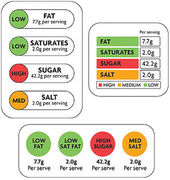
Doctors and consumer groups say the labeling is vital to helping families choose a healthy diet and avoid products high in fat, sugar and salt.
Shoppers support the red, amber and green color coding on the front of packs, according to research by the Food Standards Agency and consumer group Which?.
However, food giants, including Tesco, PepsiCo and Kellogg's, have spent tens of millions of pounds on a vast lobbying campaign to put an end to the scheme.
They fear the regime - that would force them to put red warnings on big-selling sugary drinks and salty snacks - would hit sales and profits.
Industry bosses will learn today if the campaign has succeeded with a vote on the future of European food and nutrition labeling in the European Parliament.
Consumer organizations fear MEPs will bow to the pressure and reject traffic lights in favor of an industry scheme that is far more complex.
European consumer group, BEUC, said the system is a vital tool to help cope with rising levels of obesity.
Its director general, Monique Goyens, said: 'Consumers have a right to clear and easy to understand information on packaging.'
She added: 'At a time when one in five Europeans are obese, there should be no reason not to empower individuals to improve their diets if they so wish.'
However, in March, the European Parliament's environment committee rejected the system by 32-30 votes, after intense lobbying by manufacturers.
The leader of Labour's MEPs, Glenis Willmott, said:
'They prefer complex labels that make it far harder for shoppers to really understand what's going in their basket.'Britain's Food and Drink Federation suggested the traffic light system would create unnecessary red tape for everyone from supermarkets 'to the person who sells jars of jam at a local farmers' market'.



... since these labels are nearly worthless anyway. For example -- to group all "fats" into one category and consider more than a tivial amount to be "bad" for your health is just plain WRONG. To put highly processed soybean oil made from GMO soy and butter made from raw organic milk sourced from grass-fed, pastured animals in the same category is just massive misinformation, at best. And what is so bad about "saturated" fats? Follow the money trail to get your answer to that question. Maybe these labels are a step in the right direction? Albeit a very small step, unfortunately.